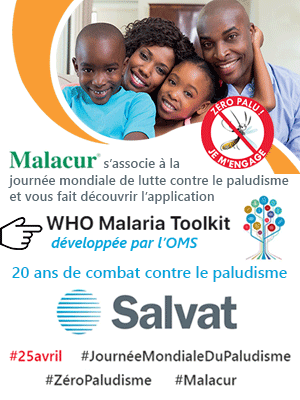← retour Santé tropicale
Accès aux sites pays ![]()
![]() BENIN
BENIN![]() BURKINA FASO
BURKINA FASO![]() CAMEROUN
CAMEROUN![]() CENTRAFRIQUE
CENTRAFRIQUE![]() CONGO
CONGO![]() COTE D'IVOIRE
COTE D'IVOIRE![]() GABON
GABON
![]() GUINEE
GUINEE![]() MADAGASCAR
MADAGASCAR![]() MALI
MALI![]() R.D. CONGO
R.D. CONGO![]() SENEGAL
SENEGAL![]() TOGO
TOGO
← retour Santé tropicale
Accès aux sites pays ![]()
![]() BENIN
BENIN![]() BURKINA FASO
BURKINA FASO![]() CAMEROUN
CAMEROUN![]() CENTRAFRIQUE
CENTRAFRIQUE![]() CONGO
CONGO![]() COTE D'IVOIRE
COTE D'IVOIRE![]() GABON
GABON
![]() GUINEE
GUINEE![]() MADAGASCAR
MADAGASCAR![]() MALI
MALI![]() R.D. CONGO
R.D. CONGO![]() SENEGAL
SENEGAL![]() TOGO
TOGO

Publié dans Médecine d'Afrique Noire 5801 - Janvier 2011 - pages 9-13
 Les hernies de Jean-Louis Petit : difficultés diagnostiques et thérapeutiques à propos de 14 cas
Les hernies de Jean-Louis Petit : difficultés diagnostiques et thérapeutiques à propos de 14 casAuteurs : R. Lebeau, B. Diane, F.B. Assamoi Kassi, S. Kacou Yenon, J.C. Kouassi - Côte d'Ivoire
But : Rapporter les difficultés diagnostiques et thérapeutiques des hernies de Jean-Louis Petit.
Matériel et méthodes : Les données diagnostiques, thérapeutiques et l’évolution post-opératoire de 14 hernies de Jean-Louis Petit, ont été colligées de 1996 à 2006.
Résultats : La série était faite de 14 patients (11 hommes et 3 femmes), d’un âge moyen de 54,7 ans (extrêmes : 38 et 74 ans). Chez une patiente la hernie a été de découverte fortuite au cours de l’examen systématique des orifices herniaires, cette patiente avait une hernie épigastrique. Les 13 patients restant avaient un syndrome occlusif (n = 3), un phlegmon pyostercoral (n = 1) et une masse lombaire (n = 9). Une échographie réalisée chez 3 patients a diagnostiqué une hernie étranglée chez l’un et un lipome, chez les 2 autres. Les diagnostics préopératoires étaient un syndrome occlusif (n = 3), une hernie de Jean Louis Petit étranglée (n = 1) et non-étranglée (n = 6), un lipome (n = 3), un phlegmon pyostercoral (n = 1). Le diagnostic de hernie de Jean-Louis Petit était donc connu en préopératoire, chez 7 patients. Le patient qui avait le phlegmon pyostercoral, n’a pu être opéré car décédé d’une septicémie. Treize patients ont donc été opérés. La cure de la hernie réalisée par raphie dans tous les cas a été effectuée par voie lombaire (n = 10) ou transpéritonéale (n = 3), chez deux de ces trois patients une résection avec anastomose immédiate pour nécrose intestinale, a précédé la cure herniaire. L’un des patients qui a subi une résection anastomose, est décédé dans la période post-opératoire immédiate des suites d’un collapsus cardio-vasculaire. La durée moyenne du suivi des patients, a été de 15 mois (extrêmes : 8 mois et 25 mois), au cours desquels on a noté une récidive au bout de 13 mois, chez un patient, ce patient a refusé la réintervention et est décédé 4 mois plus tard, d’une insuffisance cardiaque décompensée.
Conclusion : Le diagnostic de hernie de Jean-Louis Petit doit être évoqué devant une masse lombaire inférieure ou un syndrome occlusif. Les difficultés thérapeutiques doivent faire préférer le traitement prothétique.
Objectives: This study aimed to investigate the diagnostic and therapeutic pitfall of inferior lumbar hernia and to determine the outcome of the surgical procedure.
Materiel and methods: Diagnostic, therapeutic and post-operative data of 14 inferior lumbar hernias were studied retrospectively from 1996 to 2006.
Results: Fourteen inferior lumbar hernias were recorded with 11 men and three women. Their mean age was 54.7 years (range 38 to 74 years). One hernia was incidentally found in a woman with epigastric hernia and the remaining thirteen patients were complaining with lumbar mass (n = 9), bowel obstruction (n = 3) and lumbar hernia abscess (n = 1). Preoperative diagnosis were lipoma (n = 3), strangulated inferior lumbar hernia (n = 1), non strangulated inferior lumbar hernia (n = 6), bowel obstruction (n = 3) and lumbar hernia abscess (n = 1). Lumbar hernia was preoperatively known in seven patients. All patients but the one with lumbar hernia abscess who died preoperatively underwent surgery. Surgical procedure was excision of the sac and repair by surrounding tissue in all cases. Two patients with intestinal necrosis underwent bowel resection with immediate anastomosis, another patient underwent epigastric hernia repair. One patient died post-operatively. Mean post-operative follow-up was 15 months (range 8-25 months). One recurrence occurs 13 months later but this patient refused reoperation and died four months after the discovery of the recurrence.
Conclusion: The typical manifestation of inferior lumbar hernia is a mass of the lower triangle; but if gut is incarcerated bowel obstruction may develop. Repair of such hernia should be best archived by using prosthetic material.
Cet article est actuellement coté ![]() (1,0 étoiles) par les abonnés de Médecine d'Afrique Noire.
(1,0 étoiles) par les abonnés de Médecine d'Afrique Noire.
Il a été consulté 3213 fois, téléchargé 112 fois et évalué 1 fois.
Aucun commentaire n'a encore été ajouté à propos de cet article
Restez informés : recevez, chaque mercredi, la lettre d'informations de Santé tropicale. Inscriptions
Ce contenu gratuit vous est destiné :







![]() Adresse
Adresse
![]() Téléphone
Téléphone
![]() Contactez-nous
Contactez-nous
Actualités
Articles médicaux